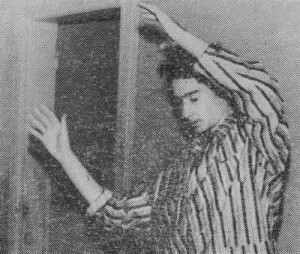 Catatonic syndrome is a mental pathology in which motor disorders occur. Violation can occur in any mentally unhealthy person.
Catatonic syndrome is a mental pathology in which motor disorders occur. Violation can occur in any mentally unhealthy person.
The development of this syndrome in old age is a rarity: most often the disease occurs at the age of 17 to 30 years.
Catatonia species
There are such varieties of catatonia:
- Catatonic schizophrenia , which refers to the pathologies of the psyche. This form of the syndrome is characterized by psychomotor disorders, during which stupor and excitement replace each other, leaking against the background of other signs of the disease. Patients still have an understanding of reversed speech: they remember everything that happens, but actions can occur against their will.
- Catatonic excitation of has two forms. The first is characterized by pretentious speech, exaltation, arrogance,
 foolishness. The patient's consciousness remains clear, and he himself may not understand what is happening. Impulsive catatonia is characterized by aggressiveness towards others, as well as a potential danger to the patient. The second form - silent excitation, is accompanied by a confusion of consciousness, unreasonable aggression, display of negativism.
foolishness. The patient's consciousness remains clear, and he himself may not understand what is happening. Impulsive catatonia is characterized by aggressiveness towards others, as well as a potential danger to the patient. The second form - silent excitation, is accompanied by a confusion of consciousness, unreasonable aggression, display of negativism.
- Catatonic stupor has several forms and arises after excitation. There is immobility, disconnection from the world of the patient. The pathological condition is noted for a rather long period.
In its turn, the catatonic stupor passes through several stages of development: the
- stupor with the waxy flexibility is characterized by the absence of the patient's reaction to external stimuli, even pain;
- for negativistic stupor is characterized by complete immobility, the patient does not allow himself to dress, feed, raise, and then - to lay;
- stupor with numbness is expressed by the fact that the patient always lies in the embryo position, with what, his lips are collected "in the tube"( proboscis syndrome).
Causes and risk factors for the development of
The main predisposing factors for the onset of catatonic syndrome are a variety of mental abnormalities - for example, schizophrenia or psychosis.
Catatonia often develops if the patient:
- is rapidly progressing neoplastic diseases of the brain ;
- in anamnesis - -transferred craniocerebral trauma ;
- has autism, epilepsy ;

- complicated flowing infectious diseases ;
- acute mental disorders due to pregnancy and childbirth ;
- the presence of thrombocytopenic purpura ;
- the presence of neurological lesions of the brain ;
- addiction ;
- occurs therapy with drugs that contain psychoactive substances .
Many aspects, including the causes and risk factors for the development of this syndrome, are not fully explained by scientists.
The most typical manifestations of
Symptoms of catatonia largely depend on the age and underlying disease that the patient has. The most common signs of catatonic syndrome: the
- patient repeatedly repeats the same phrase, the movement;
- is imitated by other people;
- expressed various forms of negativity;
- marks catalepsy - a long stay in a certain, perhaps even uncomfortable, position;
- there are hallucinations, nonsense, a sharp change of mood even in the presence of clarity of consciousness.
 After the patient has left the state of catatonia, he can completely forget about the experience, or have vague, fragmentary memories of the manifestation of the syndrome. There are cases when the patient clearly and clearly recalls all the details of what happened to him.
After the patient has left the state of catatonia, he can completely forget about the experience, or have vague, fragmentary memories of the manifestation of the syndrome. There are cases when the patient clearly and clearly recalls all the details of what happened to him.
Catatonic arousal often flows into a stupor, which is characterized by complete immobility of the patient, increased muscle tone, limbs acquire a blue tint, blood pressure decreases.
In childhood, catatonia is manifested in the repetition of what was said by adults, the constant fulfillment of stereotyped rhythmical movements.
Patient examination and diagnosis of
The examination is carried out by a psychiatrist who, by identifying the symptoms of catatonia, identifies the disease that triggered her appearance.
If there is a suspicion that the patient is suffering from schizophrenia, mania or depression, a detailed anamnesis is drawn up, which reflects, among other things, all hereditary complications.
If the patient is completely contact, the doctor finds out all the details of the catatonic syndrome. In the absence of the possibility of normal communication with the patient, the psychiatrist, based on the patient's behavior, observes the presence of delirium and hallucinations.
Catatonic schizophrenia manifests itself in that for at least half a month, one of the symptoms described is manifested:
- stupor;
- catalepsy;
- excitement;
- any form of negativity;
- Stiffness;
- unquestioning, thoughtless( automatic) submission by the order of the personnel of the medical institution.
If depression and mania associated with mental disorders are diagnosed, the presence of a stupor -  - is completely sufficient. The remaining signs are secondary.
- is completely sufficient. The remaining signs are secondary.
The use of narcotics as a cause of catatonia is revealed in the compilation of a detailed anamnesis, based on data from narcological dispensaries, description of the situation by relatives and on the basis of signs indicating dependence.
Additional studies are conducted taking into account the specificity of the revealed pathological process. However, compulsory are:
- general and biochemical blood tests, urine.
- bacteriological culture.
- CT and MRI.
Assisting
Treatment is performed under the supervision of a physician, in a psychiatric hospital. If a patient develops a severe degree of somatic disease, he is hospitalized in the appropriate department of the medical institution.
Patients with catatonic syndrome of a high degree of excitement are regularly administered sedatives, with which, he must be fixed to the bed.
The patient is fully treated. If catatonia lasts a long period, the food should be administered intravenously( parenterally) in order to avoid exhaustion and dehydration of the body.
 Catatonic stupor is characterized by long-term immobility of a person, which disrupts its activity and can lead to certain physiological problems. If the patient is in the same position for a long time, it must be turned over so that no pressure ulcers develop on the body.
Catatonic stupor is characterized by long-term immobility of a person, which disrupts its activity and can lead to certain physiological problems. If the patient is in the same position for a long time, it must be turned over so that no pressure ulcers develop on the body.
Drug treatment is often that a patient with catatonic syndrome is administered low doses of benzodiazepines.
In the absence of a therapeutic effect, electroconvulsive therapy is performed: its advantage lies in the fact that a positive result is highly probable with all forms of catatonic syndrome without exception.
Carbamazepine provides supportive treatment, but in higher doses it is also used for acute care in case of exacerbation of the disease. Very carefully, antipsychotics should be prescribed, as this group of  drugs increases the likelihood of neuroleptic syndrome.
drugs increases the likelihood of neuroleptic syndrome.
In the course of drug therapy, Zolpidem is often used;antiglutamate agents are quite effective. Simultaneously with the therapy, the patient's condition is monitored.
During the period of catatonic excitement, the patient's actions are unconscious, impetuous and unpredictable, often accompanied by aggression. Therefore, the patient can harm himself or others, which requires his isolation from society and fixation in one place.
Thus, catatonic syndrome is characterized by a destructive effect on the patient's body and is a source of danger for those around him.



